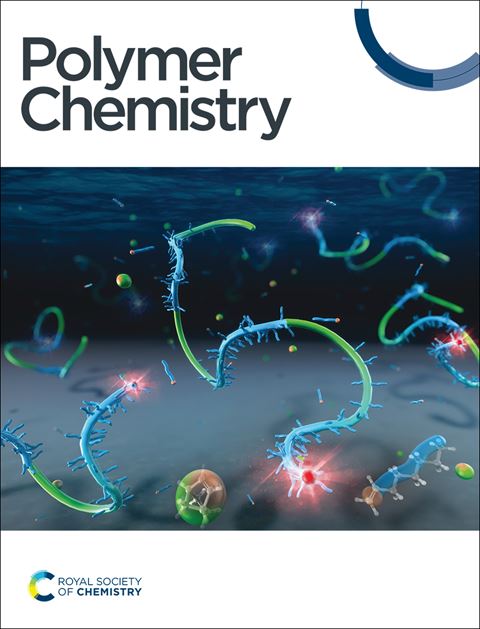Rational decoration of porous organic polymers with silver nanoparticles for strategic reduction of hazardous nitroaryl compounds†
IF 3.9
2区 化学
Q2 POLYMER SCIENCE
引用次数: 0
Abstract
Porous organic polymers (POPs) have garnered significant attention across various industries due to their promising physicochemical properties. In this study, we employ the classical Friedel–Crafts alkylation strategy to synthesize two types of porous organic polymers, namely Py–CH POP and TPA–CH POP, utilizing chloranil (CH), pyrene (Py), and triphenylamine (TPA) as building blocks. The Py–CH POP exhibits coaxial-like morphologies, uniform micropores, and a moderate surface area of up to 822 m2 g−1, along with excellent thermal stability, recording a char output of 69.6 wt%. Notably, these CH POPs contain dynamic hydroxyl groups that can effectively attract Ag+ ions from silver nitrate solutions and facilitate their reduction into silver nanoparticles, resulting in the formation of Ag@Py–CH and Ag@TPA–CH POP nanocomposites. These nanocomposites serve as efficient nano-catalysts for the reduction of hazardous p-nitrophenol (p-NP) to the safer p-aminophenol (p-AP) at ambient temperature. Importantly, the Ag@Py–CH and Ag@TPA–CH POP nanocomposites demonstrate comparable normalized reduction rates of p-NP, reaching up to 65.3 mg s−1. The quaternary amine sites in the Ag@TPA–CH POP nanocomposites play a crucial role in this catalytic reaction, enhancing interactions with the phenolic hydroxyl groups of p-NP and thereby accelerating the reduction process compared to Ag@Py–CH POP. This strategy presents a dynamic approach for the reduction of p-NP, leading to the clean production of p-AP.

用纳米银粒子合理装饰多孔有机聚合物,实现有害硝基芳基化合物的战略性还原
多孔有机聚合物(POPs)因其良好的物理化学特性而在各行各业受到广泛关注。在本研究中,我们采用经典的 Friedel-Crafts 烷基化策略,以氯苯胺 (CH)、芘 (Py) 和三苯胺 (TPA) 为构建基块,合成了两种多孔有机聚合物,即 Py-CH POP 和 TPA-CH POP。Py-CH POP 具有同轴状形态、均匀的微孔和高达 822 m²/g 的适中表面积,同时具有出色的热稳定性,记录的炭产量为 69.6 wt%。值得注意的是,这些 CH 持久性有机污染物含有动态羟基,能有效吸引硝酸银溶液中的银⁺离子,并促进其还原成银纳米粒子,从而形成 Ag@Py-CH 和 Ag@TPA-CH 持久性有机污染物纳米复合材料。这些纳米复合材料可作为高效的纳米催化剂,在常温下将有害的对硝基苯酚(p-NP)还原成更安全的对氨基苯酚(p-AP)。重要的是,Ag@Py-CH 和 Ag@TPA-CH 持久性有机污染物纳米复合材料对对硝基苯酚的归一化还原率相当,高达 65.3 mg/s。与 Ag@Py-CH POP 相比,Ag@TPA-CH POP 纳米复合材料中的季胺位点在这一催化反应中发挥了关键作用,增强了与对-NP 的酚羟基的相互作用,从而加速了还原过程。这种策略为对-NP 的还原提供了一种动态方法,从而实现了对-AP 的清洁生产。
本文章由计算机程序翻译,如有差异,请以英文原文为准。
求助全文
约1分钟内获得全文
求助全文
来源期刊

Polymer Chemistry
POLYMER SCIENCE-
CiteScore
8.60
自引率
8.70%
发文量
535
审稿时长
1.7 months
期刊介绍:
Polymer Chemistry welcomes submissions in all areas of polymer science that have a strong focus on macromolecular chemistry. Manuscripts may cover a broad range of fields, yet no direct application focus is required.
 求助内容:
求助内容: 应助结果提醒方式:
应助结果提醒方式:


